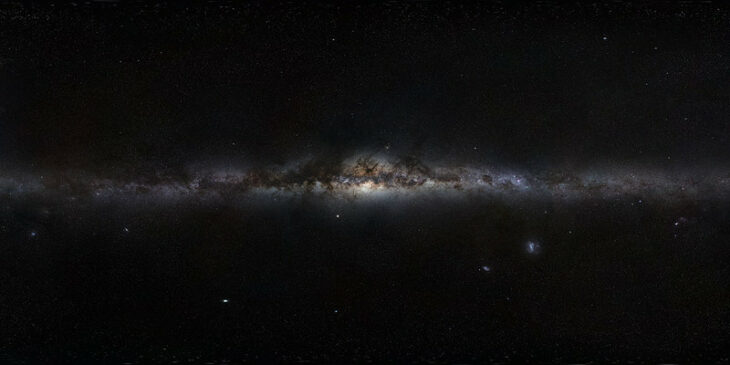When insurance companies assess fault for a vehicle collision, they rely on accident investigators. They work with limited data like the final positions of the vehicles and damage on or around them. However, with physics and computer models, investigators can deduce the speeds, directions of travel, and force of impact involved in the crash. So, from a snapshot of the present, they can decipher the history of the car accident leading to the unique final arrangement of the vehicles and debris.
Astronomers trying to decipher the history of our home Galaxy, the Milky Way, have basically the same task and methods. Except when astronomers start investigating, they have to deal with around 100 billion “cars,” all of which are still moving, and they aren’t 100% certain if a collision ever occurred. An international team of astronomers recently took on the task of recreating the Milky Way’s history starting with 2 leads. First, its shape is that of a barred spiral galaxy. Second, it’s about 100 million years younger than the 14 billion-year-old universe.

A galaxy 65 million lightyears (4 with 20 0’s after it miles or 6 with 20 0’s after it kilometers) away from Earth with a similar shape to the Milky Way. Because we are inside the Milky Way, we cannot take face-on images of it. “Barred Spiral Galaxy NGC 1300” by NASA Hubble is licensed under CC BY 2.0.
The astronomers analyzed data from 10 million red giant stars observed with the Gaia mission’s telescopes to ensure that the stars would all be similar and bright enough to get a representative sample across the Galaxy. The team determined where the stars were, using a coordinate system called galactic coordinates, and their distance from Earth. They also calculated how fast they were moving and in what direction. Like with a vehicle collision, the scientists used these pieces of information to “rewind the stars” and see where they came from.
The astronomers also needed to know the chemical properties of the stars. In particular, they noted the amount of material in them that isn’t hydrogen or helium, known as their metallicity, and the amount of material formed by nuclear fusion of helium, known as their alpha process elements. Because not all elements were formed in the Big Bang, a star with high metallicity formed at a later time and place when elements besides hydrogen and helium existed in abundance. Similarly, a star with more alpha process elements has evolved further in its life cycle than one with fewer alpha process elements.
The astronomers compiled these data for each star and used simulation software called TNG50 to test 61 different scenarios of how the Galaxy might have formed. Once they found a specific sequence of events that yielded an output closest to the real data, they condensed their results into a 3-phase history of the Galaxy, with each phase corresponding to a defining event.
They suggested the first phase consisted of the Galaxy before its distinct disk shape formed, referred to as the protogalaxy (13.6 to 11 billion years ago). Back then, stars emerged and moved randomly, with the team describing this period as “chaotic and disordered.” Ancient stars that formed during this phase still move disorganizedly but are concentrated near the center of the Milky Way.
At the end of the protogalaxy phase, gravity pulled all the stars in the disk closer together, causing them to spin faster around the Galactic center until the Galaxy reached its second stage, the hot disk phase (11 to 8 billion years ago). Back then, the Galaxy’s iconic flat spiral disk shape formed. Stars emerged in periodic bursts at a higher average rate than today, at more than 1.6 solar masses per year. Additionally, the astronomers interpreted discrepancies in metallicity among stars from the hot disk phase as evidence of the Milky Way merging with another smaller galaxy.
They suggested we are currently in the third phase of our Galaxy’s history, defined by stars orbiting in orderly circles. Stars with high metallicities orbit toward the resource-rich center of the Galaxy, and stars with low metallicities orbit toward the sparse edges. They called this phase the cold disk phase (8 billion years ago to the present) because its defining event has been a reduction or “cooldown” in how chaotically stars orbit the center of the Galaxy.
The astronomers concluded that their simple picture can reproduce the overall structure of the Milky Way. However, they also noted that an improved study would require data from more stars and the precise ages of those stars rather than the indirect age indicators they used.


